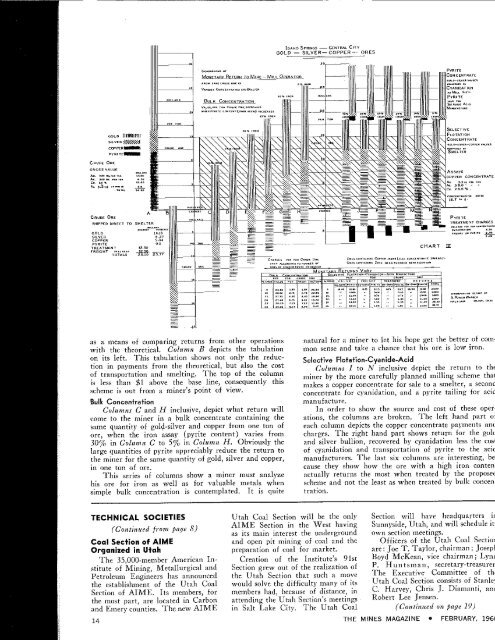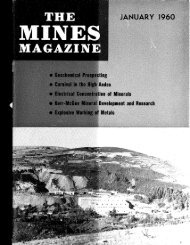THE MAGAZIN - Mines Magazine - Colorado School of Mines
THE MAGAZIN - Mines Magazine - Colorado School of Mines
THE MAGAZIN - Mines Magazine - Colorado School of Mines
Create successful ePaper yourself
Turn your PDF publications into a flip-book with our unique Google optimized e-Paper software.
IDAHO Sprawcs — CrNTRAL CITY<br />
G O L D — S I L V E R — C O P P E R — O R E S<br />
Operation<br />
Mohole*<br />
By<br />
WILLARD BASCOM, x-'42<br />
WILLARD BASCOM<br />
as a means <strong>of</strong> comparing returns from other operations<br />
with the theoretical. Column B depicts the tabulation<br />
on its left. This tabulation shows not onlj' the reduction<br />
in payments from the theoretical, but also the cost<br />
<strong>of</strong> transportation and smelting. The top <strong>of</strong> the column<br />
is less than $1 above the base line, consequently this<br />
scheme is out from a miner's point <strong>of</strong> view.<br />
Bulk Concenfra+ion<br />
Colinnns C and H inclusive, depict what return will<br />
come to the miner in a bulk concentrate containing the<br />
same quantity <strong>of</strong> gold-silver and copper from one ton <strong>of</strong><br />
ore, when the iron assay (pyrite content) varies from<br />
30% in Cohmin C to 5% in Colvnn H. Obviously the<br />
large quantities <strong>of</strong> pyrite appreciably reduce the return to<br />
tbe miner for the same quantity <strong>of</strong> gold, silver and copper,<br />
in one ton <strong>of</strong> ore.<br />
Tbis series <strong>of</strong> columns show^ a miner must analyze<br />
his ore for iron as well as for valuable metals when<br />
simple bulk concentration is contemplated. It is quite<br />
TECHNICAL<br />
SOCIETIES<br />
(Continued from page 8)<br />
Selecfive Fl<strong>of</strong>ation-Cyanide-Acid<br />
Columns 1 to inclusive depict the return to the<br />
miner by the more carefully planned milling scheme that<br />
makes a copper concentrate for sale to a smelter, a second<br />
concentrate for cyanidation, and a pyrite tailing for acid<br />
manufacture.<br />
In order to show the source and cost <strong>of</strong> these operations,<br />
the columns are broken. The left hand part <strong>of</strong><br />
each column depicts the copper concentrate payments and<br />
charges. The right hand part shows return for the gold<br />
and silver bullion, recovered by cyanidation less the cost<br />
<strong>of</strong> cyanidation and transportation <strong>of</strong> pyrite to tbe acid<br />
manufacturers. The last six columns are interesting, because<br />
they show how the ore with a high iron content<br />
actually returns the most when treated by the proposed<br />
scheme and not the least as when treated by bulk concentration.<br />
Coal Section <strong>of</strong> AIME<br />
Organized in Utoh<br />
The 35,000-member American Institute<br />
<strong>of</strong> Mining, Metallurgical and<br />
Petroleum Engineers has announced<br />
the establishment <strong>of</strong> the Utah Coal<br />
Section <strong>of</strong> AIME. Its members, for<br />
the most part, are located in Carbon<br />
and Emery counties. The new AIME<br />
14<br />
Utah Coal Section will be the only<br />
AIME Section in the West having<br />
as its main interest the underground<br />
and open pit mining <strong>of</strong> coal and the<br />
preparation <strong>of</strong> coal for market.<br />
Creation <strong>of</strong> the Institute's 91st<br />
Section grew out <strong>of</strong> the realization <strong>of</strong><br />
the Utah Section that such a move<br />
would solve the difficulty many <strong>of</strong> its<br />
members had, because <strong>of</strong> distance, in<br />
attending the Utah Section's meetings<br />
in Salt Lake City. The Utah Coal<br />
natural for a miner to let his hope get the better <strong>of</strong> common<br />
sense and take a chance that his ore is low iron.<br />
<strong>THE</strong><br />
Section will have headquarters in<br />
Sunnyside, Utah, and will schedule its<br />
own section meetings.<br />
Officers <strong>of</strong> the Utah Coal Section<br />
are: Joe T. Taylor, chairman ; Joseph<br />
Boyd McKean, vice chairman; Lynn<br />
P. Huntsman, secretary-treasurer.<br />
Tbe Executive Committee <strong>of</strong> the<br />
Utah Coal Section consists <strong>of</strong> Stanley<br />
C. Harvey, Chris J, Diamanti, and<br />
Robert Lee Jensen.<br />
(Continued on page 19)<br />
INES <strong>MAGAZIN</strong>E • FEBRUARY, 1960<br />
What lies beneath thc earth's crust Earth scientists<br />
and oilmen are mustering all available geological and<br />
geophysical data, deep drilling techniques, scientific and<br />
engineering knowledge, and financial assistance to answer<br />
thc age-old question,<br />
A project is now being planned to drill a hole completely<br />
through the oceanic crust to obtain samples <strong>of</strong> the<br />
mantle-—-probably to a depth <strong>of</strong> 30,000 ft. The mammoth<br />
undertaking is sponsored by the AMSOC committee <strong>of</strong><br />
thc U. S. National Academy <strong>of</strong> Sciences. Current plans<br />
suggest that the project will be a two-phase program. The<br />
first phase would test deep-drilling techniques and sampling<br />
upper layers,<br />
Tbe undertaking is called the Mohole project, named<br />
for the prime objective <strong>of</strong> the hole—the Moho, the indefinite<br />
and little-known boundary between the earth's<br />
crust and mantle. The word Moho comes from Pr<strong>of</strong>essor<br />
A. Mohorovicic <strong>of</strong> Yugoslavia, who first described the<br />
seismic discontinuity at that point.<br />
Where will the Mohole be drilled How deep will<br />
it be How much will it cost Who will pay for it<br />
When can it be drilled<br />
These are questions that are now being solved. Although<br />
it was first suggested that the hole be drilled from<br />
an oceanic island to a depth <strong>of</strong> 33,000 to 50,000 ft., it<br />
is now believed possible to probe the Moho more easily<br />
from a floating drilling platform anchored in open ocean,<br />
where the earth's crust is the thinnest. At certain locations<br />
where the water depth is from 10,000 to 18,000 ft.,<br />
the Mohorovicic discontinuity may be penetrated at 28,000<br />
to 35,000 ft. below the ocean surface. This means only<br />
13,000 to 18,000 ft. <strong>of</strong> actual drilling. How hard the<br />
drilling will be is anyone's guess.<br />
Total cost <strong>of</strong> the preliminary tests, equipment and<br />
actual drilling is estimated at $15,000,000, The AMSOC<br />
group has now been formally organized so that it can receive<br />
funds from the U. S, National Science Foundation<br />
and from private interests to finance the Mohole, Collection<br />
<strong>of</strong> needed data and re-evaluation <strong>of</strong> the most<br />
promising areas are under waj'.<br />
* 'I'his article is bointc publislied with the pevmissioji <strong>of</strong> <strong>THE</strong> PETRO-<br />
LICTIM ENGINEER (For JlanaReTueut), wiieie it apDearecl in the Austist<br />
1359 i.'isuc, Vol. XXXI, No. 9.<br />
<strong>THE</strong> AUTHOR<br />
PFillard Bascom, wbo attended the <strong>Colorado</strong> <strong>School</strong><br />
<strong>of</strong> <strong>Mines</strong> from July 1938 io May 1942, is technical director<br />
for the AMSOC Cotnmittee <strong>of</strong> the National Academy<br />
<strong>of</strong> Sciences-National Research Council in IVushington,<br />
D. C.<br />
Born Nov. 7,1916 in New York City, Bascotn studied<br />
arts at Springfield College and Columbia University, engineering<br />
and geology at the <strong>Colorado</strong> <strong>School</strong> <strong>of</strong> <strong>Mines</strong>.<br />
He left <strong>Mines</strong> just short <strong>of</strong> a degree in geological engineering,<br />
mainly because <strong>of</strong> the war, to work as a juining<br />
engineer in Arizona, Idaho, <strong>Colorado</strong> and New York.<br />
In 1945 he joi/ied the University <strong>of</strong> California al<br />
Ber/celey as research engineer, directing a field party concerned<br />
with the study <strong>of</strong> waves, beaches and shoreline<br />
structures. During the sutnmer <strong>of</strong> 1951 he was a participant<br />
in the NRC-NEL study on. mine-rouiitertneasures,<br />
and in 1951-52 he was a lecturer on Naval post-graduate<br />
school courses in oceanography.<br />
In 1951 he joined the Scripps Institution <strong>of</strong> Oceanography<br />
at La Jolla as research engineer principally concerned<br />
with fhe instrumentation <strong>of</strong> the nuclear bomb<br />
tests at the Pacific Proving Grounds. Tivo years later<br />
Bascom sailed on Expedition Capricorn through the equatorial<br />
Pacific, returning as senior scientist on the R. P.<br />
Spencer P. Baird.<br />
In 1954 he joined ihe National Academy <strong>of</strong> Sciences<br />
staff as technical director for ihe Cotnmittee on Civil Defense<br />
and in 1956 became executive secretary <strong>of</strong> the Committee<br />
on Meteorology and Oceanography. He was U. S.<br />
delegate in 1957 io the International Geophysical Year<br />
Conferences on Oceanography (Sweden) and Atmospheric<br />
Radioactivity (Holland). He also was a contributor to<br />
the Rockefeller Brothers Fund Special Study Group<br />
(future <strong>of</strong> ihe U. S. Navy), and from 1956 through 1958<br />
acted as a consultant to the President's Committee on<br />
Government Organization.<br />
Bascom spent nine jnonths <strong>of</strong> 1957 in French Oceania<br />
installing IGY wave-measuring instrunents and writitig<br />
on Polynesian history. In 1958 he served as executive secretary<br />
<strong>of</strong> the Maritime Research Advisory Committee. He<br />
is currently technical director for the AMSOC Comtnittee<br />
<strong>of</strong> the NAS-NRC and is a member <strong>of</strong> the American Geophysical<br />
Union and ihe American Associatioti for ihe Advancement<br />
<strong>of</strong> Science.<br />
<strong>THE</strong> MINES <strong>MAGAZIN</strong>E • FEBRUARY, 1960 15

















